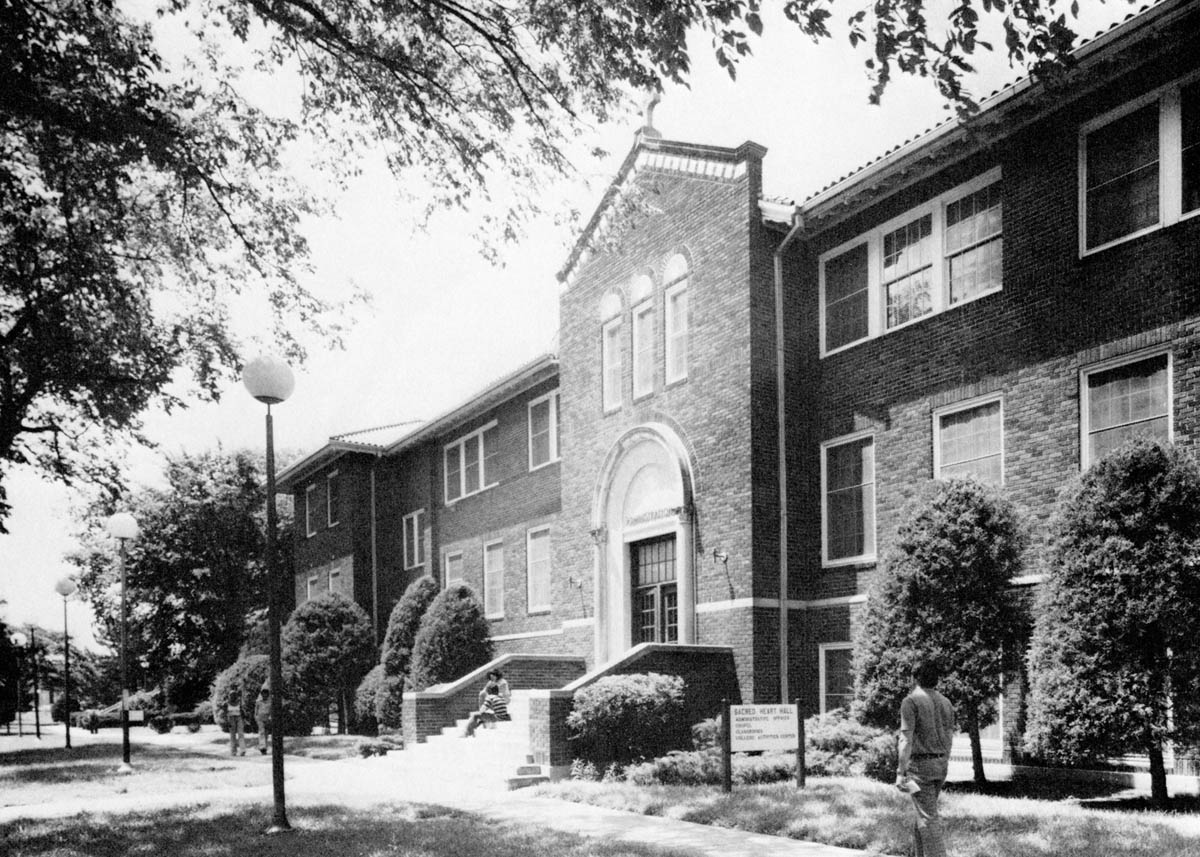
Celebrating the heart and soul of Newman University
The heart of campus turns 100 years old
The center of the Newman campus, Sacred Heart Hall, is in the midst of celebrating 100 years. The oldest building on university grounds was being constructed a century ago and on Sept. 12, 1922, the community marked a special occasion — the laying of the structure’s cornerstone. Sacred Heart was dedicated nine months later on June 24, 1923.
The building is more than just a structure; it has served as a home and constant presence throughout every stage of Newman University’s history.

Newman President Kathleen S. Jagger, Ph.D., MPH, pointed out that every student at Sacred Heart Academy, Sacred Heart Junior College, Sacred Heart College, Kansas Newman and Newman University has “likely been in this building at some point in time.
“I often say Sacred Heart is the heart and soul of our campus because of all of the history it holds,” Jagger continued. “It is something that binds us all together and I believe it is something to be celebrated and appreciated for what it has done for the students throughout the decades here.”
Director of Mission Effectiveness Sister Therese Wetta, ASC, said her biggest takeaway from the Sacred Heart Hall centennial celebration is that it “is giving us an opportunity to remember.
“There are so many generations of people who have lived and worked in this building, served in this building, and the opportunity to gather and share the memories is important, significant and should be a source of joy for people,” Wetta said. “And of course, in celebrating, we’re honoring the courage and the vision of the people who helped design and build this structure as well as people who have helped renovate and change it over these hundred years.”
Explore the timeline of Sacred Heart Hall:
Looking back on history
While Sacred Heart Hall is the heart and soul of campus, it actually predates the school.
More than 100 years ago, in 1921, the land that would one day become the Newman campus consisted of a mostly clear horizon and a few buildings, one of which was St. John’s Institute.
St. John’s Institute, sometimes referred to as St. John’s Academy, was an all-girls boarding school. It was reported as having “phenomenal success” in 1903, just a year after it was established by the Adorers of the Blood of Christ (ASC) sisters. The girls who attended the academy were between 12 and 20 years old and received “thorough training in practical education and housekeeping” from the ASC sisters.

Over the years, a boys’ school was added to the academy, and additions like water and sewer systems were needed to ensure the building’s upkeep and functionality. By 1921, it was determined that improvements were not enough to support the growing enrollment of both boys and girls, and building inspectors pronounced the building unsafe.
Mother Gertrude Bohn, a sister who was appointed superior for the central ASC house in Wichita, recognized the future needs of the convent and school. She worked alongside Mother Clementine Zerr to identify an architect, Lorentz Schmidt, to draw up plans for a new building to be built on the Wichita grounds.
The completion of the new building could be attributed “in large part to Sister Gertrude’s administrative skills, and her vision for the future needs of the convent and the school,” as stated in an online blog post from the ASC sisters, May 2019.
Groundbreaking: breathing life into the heart of campus
On Sept. 12, 1922, a “triumphal procession” of students, sisters, bishop and clergy made their way from the building of St. John’s Institute to the site of Sacred Heart Hall.
The Right Rev. August J. Schwertner, Bishop of Wichita, blessed the spot destined to become the altar, which would be the “silent witness of the acts of love, devotion, heroism and self-sacrifice” (Wichita Eagle). Assisted by the priests of Wichita, Bishop Schwertner dedicated, laid and blessed the marble cornerstone at the northeast corner of the new building.
The procession wended its way to the chapel for Benediction of the Most Blessed Sacrament. The little sanctuary “glowed with the scent of sweet-smelling flowers and the altar blazed with burning candles, while the Sisters’ choir rendered devotional music suitable for the occasion.”
“The foundations of a very large structure have been laid on the grounds of St. John’s Institute. The Sisters of the Precious Blood are to be congratulated on the many years of unselfish and successful work that has made this new venture a possibility.”
—July 22, 1922, Catholic Advance, Wichita Kansas.
As stated in West-Wind Spirit-Wind (WWSW), a historical book written by Sister Helen Streck, ASC, “Everything tended to make the day happy.

“Even nature vied with the happy sisters and friends of the Institution in pouring forth its rarest treasures in abundance. The intense heat of the previous week had been dispersed by the refreshing showers and the fair rays of the brilliant sun, reflecting in the clear radiance of the azure skies, made the day an ideal, perfect one.”
On the day of the building’s dedication, Bishop Schwertner “pointed with pride to the new building as one of the greatest of its kind in the city, the diocese, the state and the community at large.” The sisters and benefactors of St. John’s Institute were recognized for their generous contributions to the estimated $175,000 cost of the building.
Merely a year later in June 1923, the new building was complete. The first occupants of the building were diocesan priests who used the building as a retreat destination. “Sisters recalled that the priests helped them carry the old chapel benches into the new building before the retreat began” (WWSW 58). The sisters then made this building their new home.
An icon of history and heritage
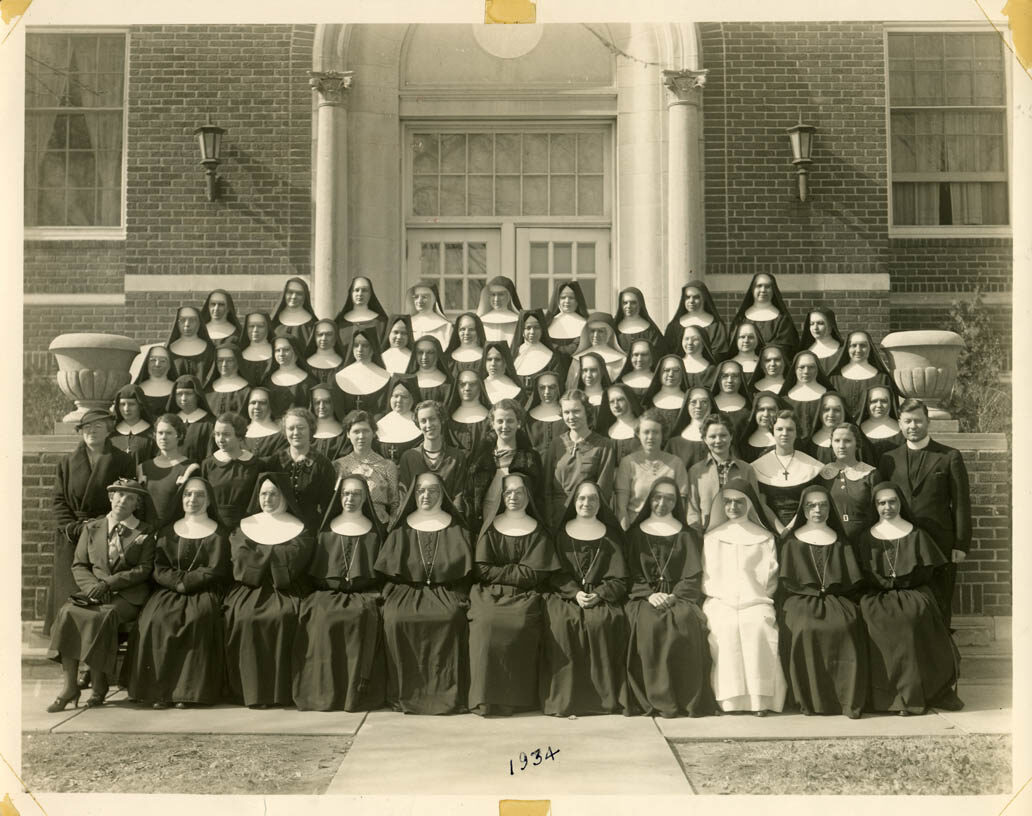
Sacred Heart Hall initially served as the new building for St. John’s Institute and was later referred to as “the administration building.” It was 258 by 60 feet, east frontage, with a basilica-style chapel of 40 by 80 feet that extended west.
The south wing was exclusively reserved for the sisters at first, while the remaining portion of the building “with its roomy dormitories, spacious classrooms and large recreation halls” would accommodate 100 young women of the new boarding school.
“Designed for style and simplicity” (Wichita Eagle), the sturdy, red brick structure was designed by architect Lorentz Schmidt with Henry “Harry” Ellis as constructor. Moore Plumbing Co., John Jones Superintendent, Mr. Roup General Foreman and Central Electrical Co. all played a role in transforming the elemental ideas of Sacred Heart Hall from paper to reality.
In October 1923, the original St. John’s Institute building was demolished. Some of the white stone from the lower floors of the building was saved and used to create Our Lady’s Grotto, which continues to stand west of Sacred Heart Hall today. This site would become a place on campus for outdoor Mass celebrations and events like the annual May Crowning ceremony.

Despite an economic depression and financial limitations, “the Sisters’ Advisory Board of the Diocese had come to the decision to begin a college, after exploring various ways of advancing teacher education in the diocese” (WWSW 113). By the grace of God and with the support of Father Leon A. McNeill as first president, they succeeded and Sacred Heart Junior College was opened in 1933.
Father Tom Welk, who has been a part of Newman University’s history since the early ‘70s, gives credit to Sacred Heart Hall for establishing a true home for students, faculty and staff over the years.
“You have to make a house a home, otherwise it’s just wood, brick and mortar,” he explained. “Once you start warming it up, then it becomes a home.”
Welk is well known for asking a simple anatomy question: “To what organ must the heart first pump blood?”
Some may answer with “brain,” “lungs” or “blood vessels,” but the answer, Welk said, is simple: “the heart.”
“Sacred Heart is the heart of the place, and the heartbeat that takes care of what needs to be done at Newman University,” he said. “I think that’s what people need to keep in mind — Sacred Heart has become a home not because of the building as much, but because of the people who have been here and ensured it becomes a home.”
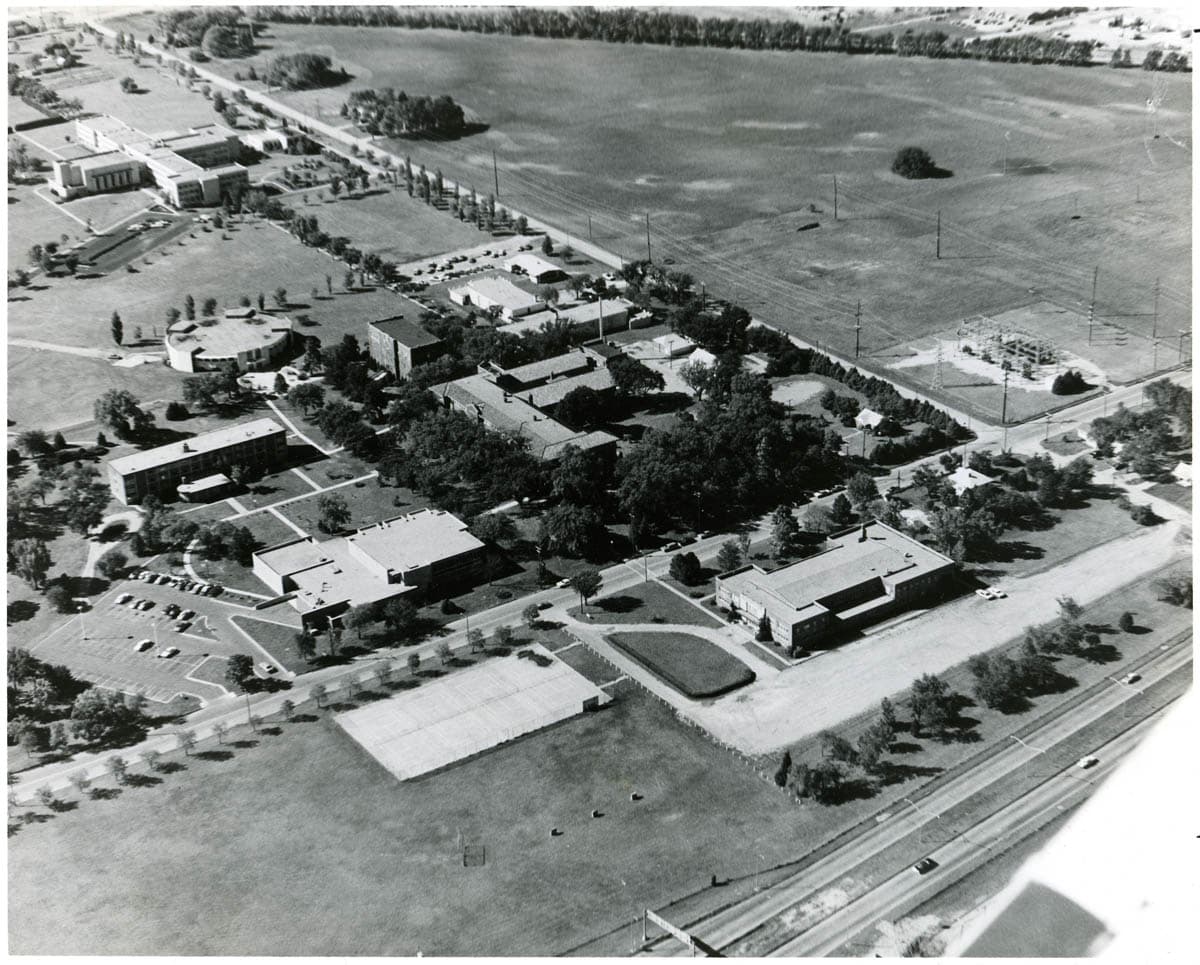
“If this building could tell stories, what would they be?”
—Newman President Kathleen Jagger
A place of living, working and learning
Walking down the familiar tile flooring on the main floor, it may seem like not much has changed in the century-old Sacred Heart Hall building. However, as decades morphed from one to the next, the spaces and places were altered to support the needs of the university at the time.
“Sacred Heart Hall has been everything from a cafeteria to a dormitory, classrooms to even athletics,” Jagger said. “There’s been a presence of every piece of the history of the university in this building.”

Some of the most significant changes have taken place on the ground floor of the building.
What is now Mail and Copy used to be the food serving area for the Newman cafeteria. Students used to eat in what is now the Sacred Heart Hall living room. The break room was once a snack bar for students and was part of the bustling Campus Activities Center (CAC), now the Martin Park Golf Learning Center. Prior to these changes, the space consisted of classrooms and the library for Sacred Heart Academy. The Newman University Archives area was once used for the bookstore.
The main floor of Sacred Heart Hall features the present-day Welcome Center, which was formerly the alumni center. The chapel has undergone three major renovations: one in 1942, one in 1994 and one in 2018, during which damaged and worn furniture was replaced and the chapel was made accessible to persons with physical limitations.



The third floor initially was dormitory space for boarders, followed by classrooms. It also once temporarily housed the campus library during the demolition of the Ryan Library. Classes continue to be held on the third floor to this day, as well as the Runway Learning Center, where students can receive academic advising, tutoring and perform make-up exams.
Believe it or not, the west wing of the main floor and third floor of Sacred Heart Hall were once used as bedrooms by the sisters before being renovated as faculty offices. In fact, Sister Tarcisia Roths, ASC, is one of the many residents whose bedroom was in the building. This area is now the offices for the Registrar and Advancement.
“I slept up in Sacred Heart Hall for quite a while,” Roths said.
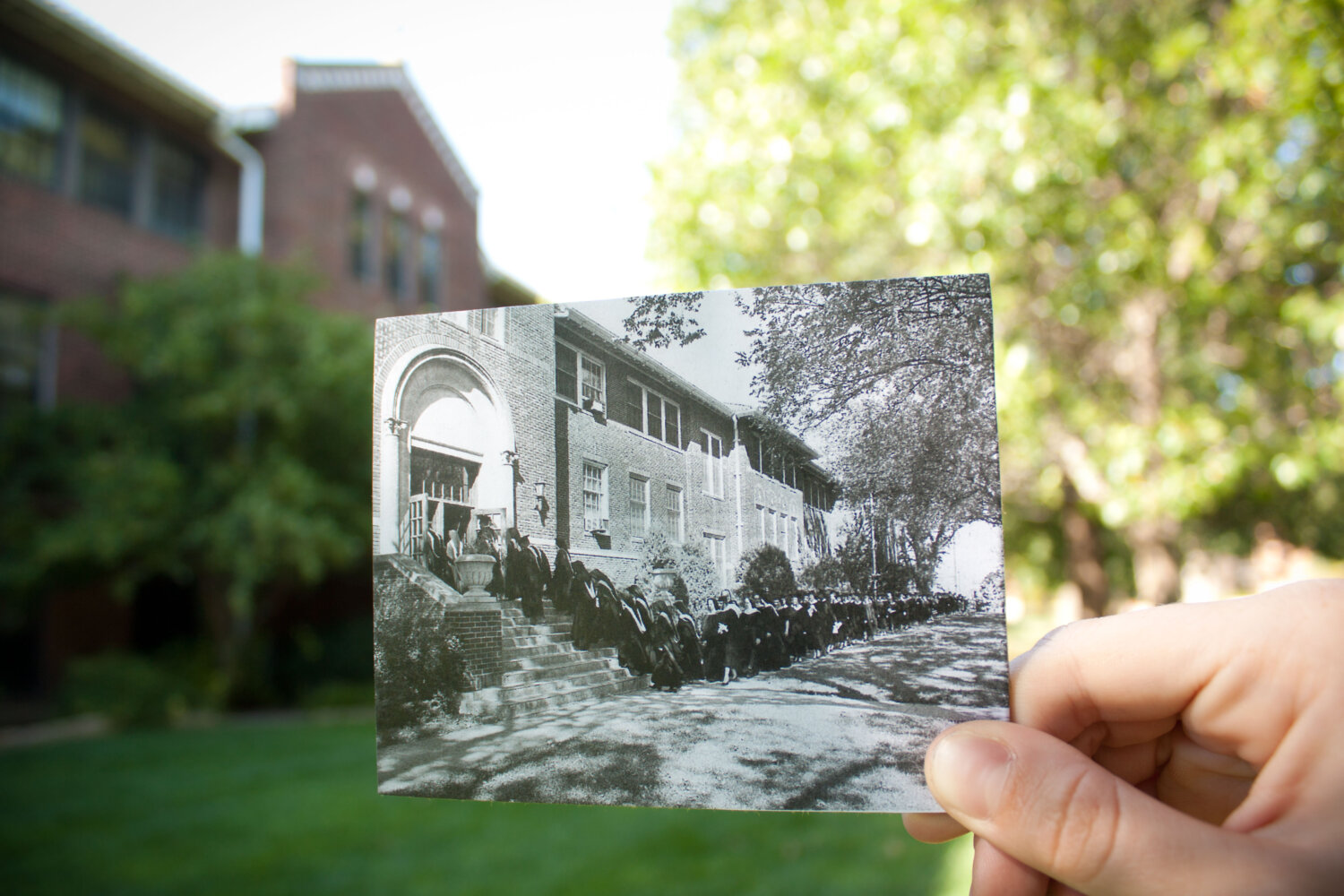
“Whether students spend most of their time in the Bishop Gerber Science Center or in De Mattias Hall, Sacred Heart Hall is the heart of the university, especially having the chapel there and the administrative offices. It represents who we are and why we’re here,” Roths added.
A blended history: ASC sisters and Sacred Heart Hall

The 100-year milestone recognizes how far the ASC sisters have come in their mission to provide an education. Worldwide, Newman University remains the only institution of higher education founded by the ASC.
“Other buildings have come and gone as needs changed, but we’ve kept Sacred Heart Hall,” said Roths, who served as the president of Kansas Newman College and Newman University from 1991-2000. “This building symbolizes our beginnings. It’s gone through many changes and it needs to go through many more.”
During Roths’ presidency, the university constructed multiple campus buildings: Eck Hall (1995), O’Shaughnessy Sports Complex (1997), Gorges Atrium (2000) and the De Mattias Fine Arts Center (2000). The Mabee Dining Center (2000) was established where the present-day maintenance building is located.
“Those buildings had to come, but they’ve all come around Sacred Heart Hall.”
Roths still remembers the first day she stepped foot in Sacred Heart Hall.
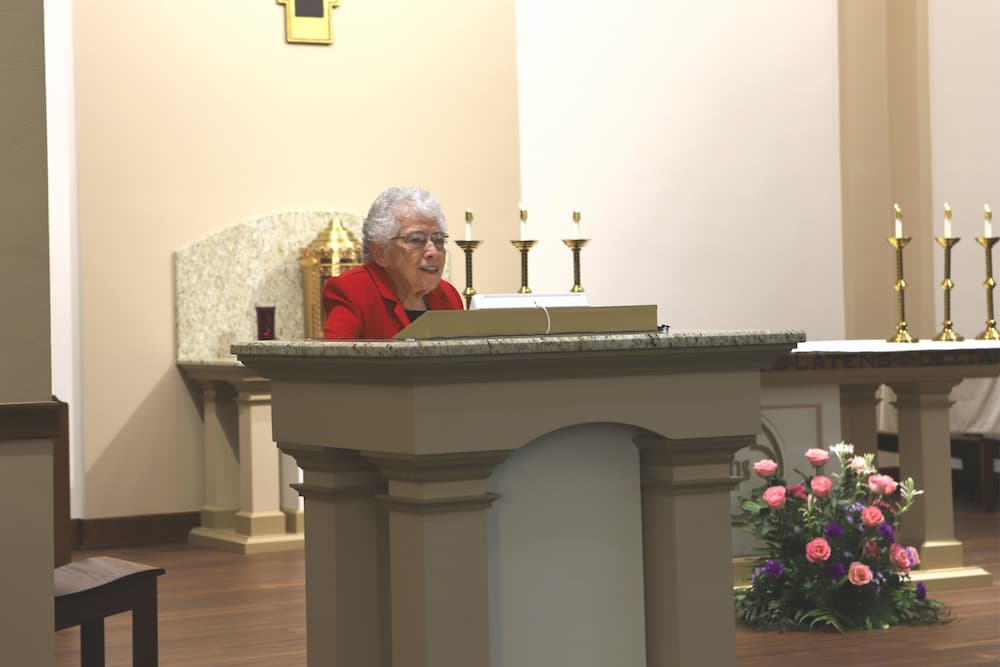
“I didn’t enter as a freshman because I was afraid I’d become a nun and I didn’t really want to be a nun,” she said with a laugh. “By the time I was a sophomore, the call was still there, so I entered the academy. My first cousin, Sister Vivian Miller, ASC, was like a sister to me and taught band so I signed up for her class. She asked me what instrument I played, and I said, ‘I don’t play an instrument. I just want to be in your class.’ So she gave me the sousaphone.”
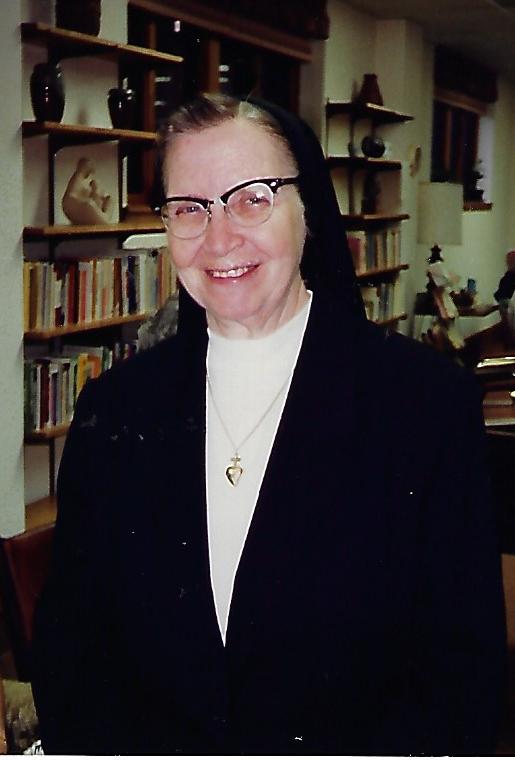
After her sophomore year, Roths entered the convent to pursue her vocation. She went on to teach and many of these classes took place in Sacred Heart Hall.
Like Roths, Wetta’s first entrance into the building was as a student. Wetta attended Sacred Heart College and her first teaching role also took place in Sacred Heart Hall. Her office as director of mission effectiveness resides across from Campus Ministry on the main floor of Sacred Heart Hall.
“Despite the building’s limitations, it was a strong learning environment even when I was a student,” Wetta said.
The ordination of a possible future saint
In the span of one century, the building has witnessed countless students, faculty, staff and sisters engaging with and adding to the university’s history. Sacred Heart Hall even served as the location of Father Emil Kapaun’s ordination as a priest.
Like many present-day Newman students, Kapaun was taught by Sister Adorers of the Blood of Christ (ASC). He took his priestly vows on June 9, 1940, in St. John’s Chapel at Newman under the same crucifix that hangs in the chapel today.
Kapaun’s ordination in St. John’s Chapel is an incredible piece of the university’s history, explained Wetta.
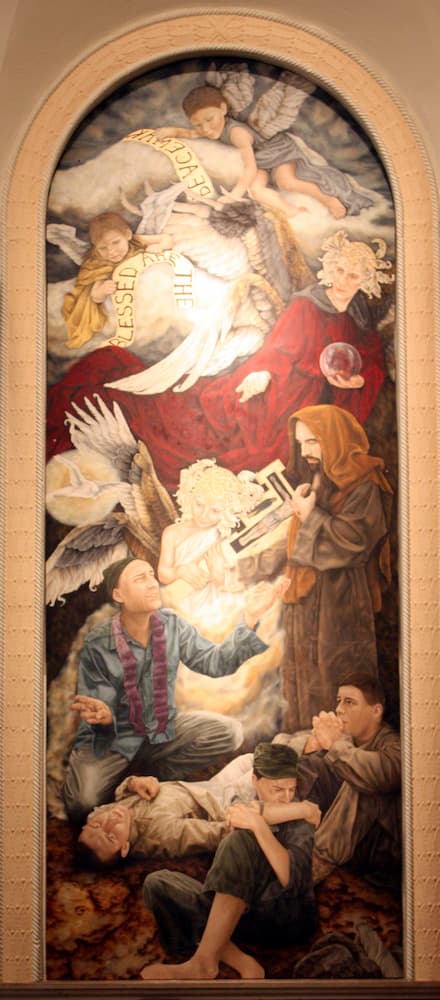
“His ordination on our campus was kind of a fluke because the priests were supposed to be ordained at the Cathedral (of the Immaculate Conception) in downtown Wichita, but it was being renovated,” Wetta said. “But now it’s such a special event in our history and when he’s canonized, this is going to make that space even more special.”
In 2009, Father John Hotze offered a special Mass during the unveiling ceremony of the Father Kapaun mural, painted by artist Wendy Lewis. The 12-foot-by-4.5-foot mural was blessed by Bishop Michael Owen Jackels in St. John’s Chapel.
In Hotze’s homily, he described that Father Kapaun “left this very chapel a changed man. He left St. John’s Chapel as a priest, ordained to serve the Universal Church in the Diocese of Wichita,” Hotze said.
Memory making
As many Catholics were grappling with the changes marked by the post-Vatican II era in the 1970s, several students struggled with their religion, Roths explained.
Alumnus Mike Ludlow ’78 was one of these students and entered his freshman year of college with a new decision on his mind.
“Instead of going to Mass, I was just going to read the Bible,” Ludlow explained. “I figured I’d get more out of it. But as the first few weeks went by, I realized I wasn’t doing that or going to Mass.”
Margaret (Schaefer) Hebenstreit ’78 invited Ludlow to go to one of the Masses that Welk was offering, and Ludlow agreed to go.
Welk, who served as university chaplain at the time, decided to bring the celebration of the Mass to the students in an unconventional setting. With the help of volunteers, he converted a third-floor classroom into a small chapel for daily Mass. Welk used a desk as the altar, and makeshift carpet squares, pillows and cushions were used instead of pews or chairs.
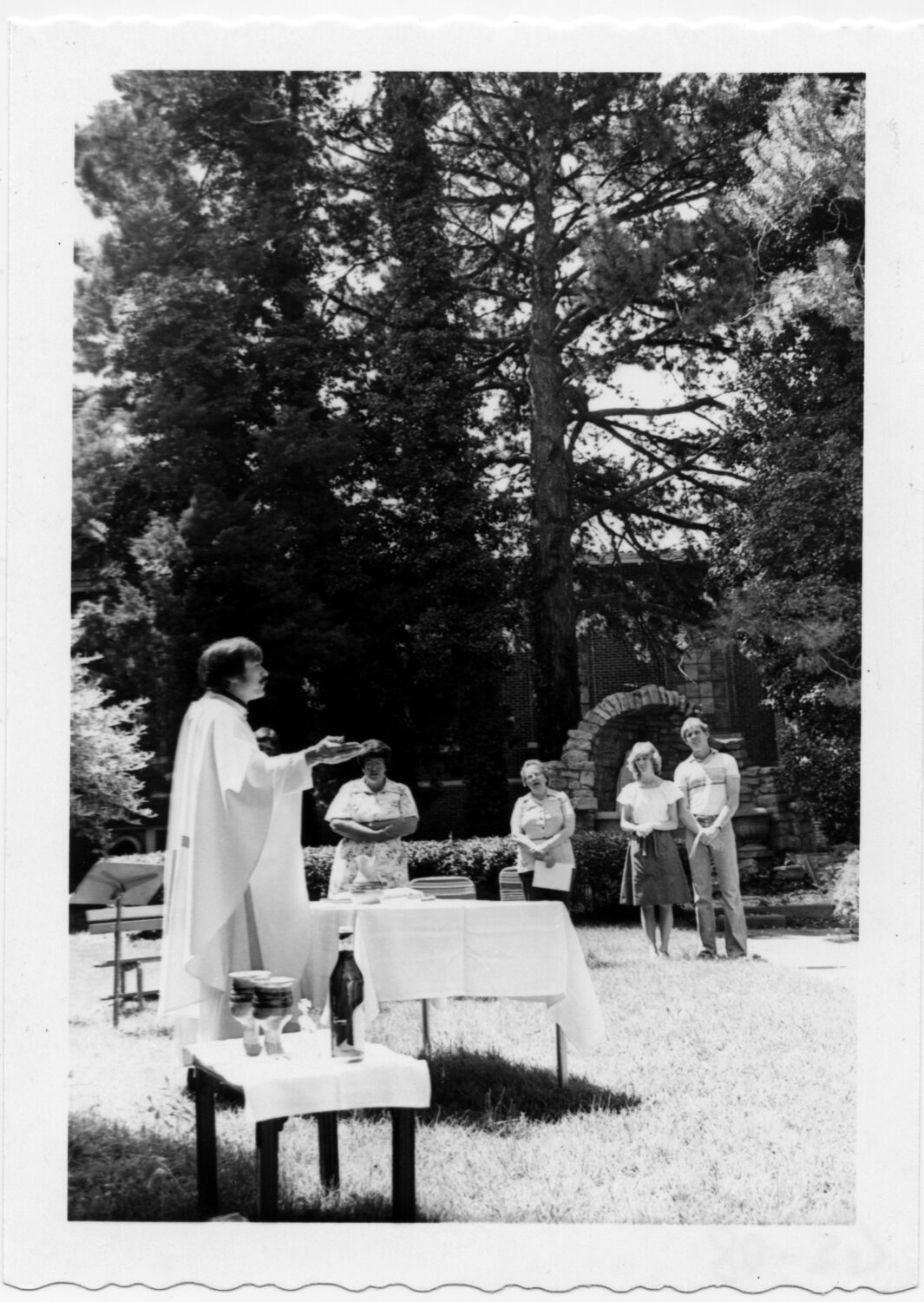
“There was a beautiful, good-sized classroom with one opening that worked perfectly,” Welk said.
What started as a one-time visit for Ludlow transformed into a weekly encounter.
Welk enlisted the help of students to make the space an even more comfortable setting, and Ludlow became one of the volunteers who set the tone of the calming atmosphere for Masses. Welk took photographs from beautiful places around the world as well as reflections on the Gospels, and asked Ludlow to put some in a slideshow to be played during the Mass.
“There were images of mountains and other places that displayed the majesty of God,” Ludlow said. “Those photos could really make you ponder your place in the world, what was important in your life and what wasn’t. It was a wonderful experience and reinforced my desire to be Catholic.”
The windows in the third-floor Sacred Heart Hall classroom looked out toward the Marian shrine, where pine trees and an eastern red cedar filled the outdoor area. Looking out at such a beautiful part of campus gave the illusion of stained glass windows, Welk said.
Students who hadn’t been to Mass in years found solace in this space with fellow Newman students. Non-Catholic students often tagged along and took part in the Masses as well.
“His homily was always a dialogue,” Roths said. “A lot of students were helped through those years. Father Tom was personable and helped them to understand what they were going through and the questions they had about what was happening in the church.”
Eventually students brought beanbag pillows, folding chairs and the crowds continued to grow as word spread of the Masses.
“We filled the room,” Welk said. “Almost invariably the students would come in, grab the pillows and find a place to sit. Sometimes they were even lined up outside the hallways.”
He continued, “It met the needs of the students. It was something that they really appreciated and found meaningful for themselves. Even married students with young kids took part, and the kids just loved to get in there and crawl around. If they got to know the students, they’d sit on one lap for a while and then another lap for a while. And they might go back to mom or dad and nobody had to worry. We didn’t hear a sound from ’em.”

Wetta described these Masses as a space where students “felt welcome and comfortable and grew in their faith.”
“The students were being formed in a different way, and it was needed at that time. It’s a testimony to the changes over time and yet the commonality is the Eucharist.”
Ludlow recalls the sounds of Mark Fox ‘78 playing the guitar, students singing and the constant click of the slideshow as one image faded into another.
Ludlow met his wife at Newman and has served the Wichita community as a family practice physician for more than 40 years. He has generously given to the university and the ASC sisters over the years.
“I’ve been back to Mass ever since,” Ludlow said. “If it hadn’t been for Father Tom, I probably wouldn’t be in the Catholic Church today.”
Modern-day memories
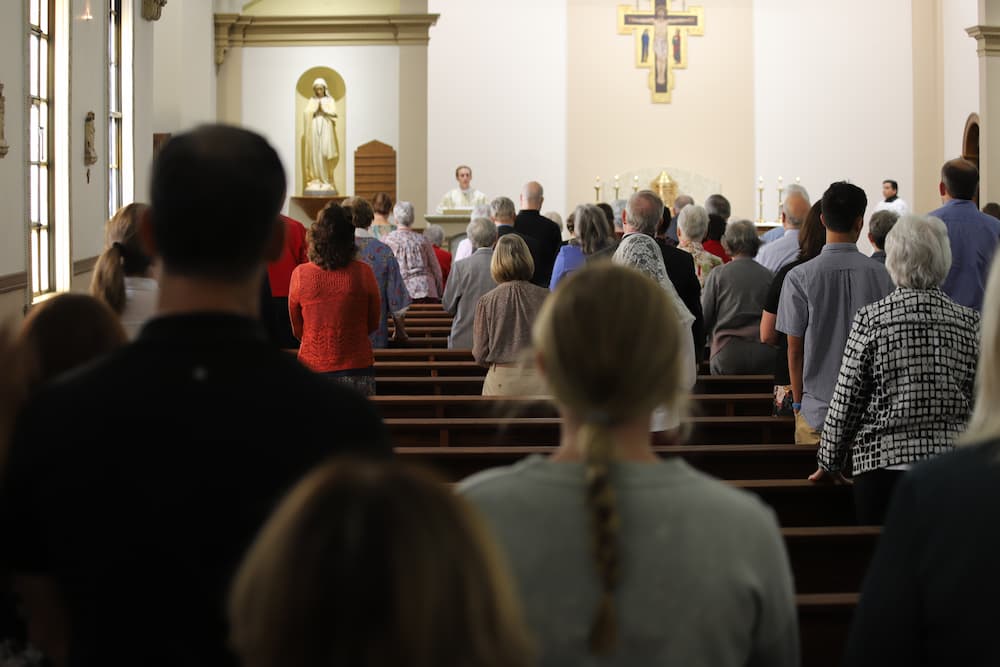
At the centennial celebration Mass of Sacred Heart Hall on Sept. 12, 2022, many alumni of Newman University took part in the Eucharistic Liturgy. Chaplain Father Adam Grelinger ’11 was the celebrant, Roths gave the welcome statement to the guests, and alumni Bob Diepenbrock ’82, Diana Stanley ’17, Jessica Sponsel ’15 and Kathleen Meyer ’63 delivered the readings and intercessions. Emily Simon ’16 served as an usher and Mary Peters ’70 played a major role in the planning committee.
Following the Sunday morning Mass of thanksgiving, guests enjoyed brunch in the Mabee Dining Center. Several told stories of their time in the beloved campus building.
One attendee, Margaret Weilert ’61, ’65, recalls first entering Sacred Heart Hall as a 7-year-old.
“I used to come out with my parents to visit my two aunts who were sister Adorers of the Precious Blood,” Weilert explained. “I had a long time of roaming these grounds and this hall. When I think of Sacred Heart Hall, I remember so many things.”
Weilert said she will never forget the classrooms where she took Latin, or the fateful day in 1963 when she learned of President J.F. Kennedy’s assassination while on the front steps of Sacred Heart Hall.
“I remember Sacred Heart Hall because that’s exactly where we all were, and there were a number of us that had that memory,” she said.

Alumni couple Kirk ’74 and Maribeth Lester ’76 met at Newman, dated at Newman, and when it came time for Kirk to pop the question, he proposed to Maribeth on the front steps of Sacred Heart Hall.
“It took me nine months to get her to date me,” Kirk said with a laugh. “She was so popular. But I was persistent. The day I proposed was Sunday, Aug. 20, 1978 around 7 p.m., and I picked her up from her house, brought her to the front steps, we talked for a little while and I asked her to marry me.”

The Lesters say Sacred Heart Hall brought them together.
“It was a very important building in our lives,” Kirk said. “The only thing that could have topped it was if they had let us get married in St. John’s Chapel.”
Even the areas surrounding the building spark memories for many alumni.
Newman was known for its city-wide Renaissance Faire, which was staged on the east side of the campus, along Southwest Boulevard in the late ’70s, ’80s and even the ’90s. The event boasted games, a pig roast, costumes, a falconer, live music and more.
The “Ren Faire” started as a class project and grew into an annual fundraiser that was celebrated for 26 straight years in Wichita.
Jenifer Stone, a two-time alumna of Kansas Newman College (’87) and Newman University (’93), witnessed the early days of the Newman Renaissance Faires as a student and has pitched in with the planning and preparation of Party on the Plaza as an alumna.

“I tell people, ’I grew up at Newman,’” Stone said. “I guess it’s just like coming home.”
Greg Lohkamp ’81 said he loved attending the first Renaissance Faires at Kansas Newman College, so he spent the recent Party on the Plaza evening reminiscing.
“It definitely brings back the memories,” Lohkamp said.
“I got to be involved as a student and then again as a young alumni,” Stone said. “It just felt right to be a part of it all again.”
Anne (Dix) Martin, a 2000 nursing alumna, served as a resident assistant (RA) during her time at Newman.

During her last week in Merlini Hall, she and fellow RAs got together, dressed up and went out to dinner as a team. When the group returned to campus, they decided to take a late night walk around campus.
“We were walking around and we decided, ‘Let’s go get our feet wet. Let’s go splash around in the (St. John Henry Newman) fountain,” Martin said. “All of a sudden we saw this truck barreling across the campus with its brights on.”
The on-duty campus security guard jumped out of the truck and asked, “What are you doing?” He then recognized the students as RAs, laughed and said, “You’re RAs, you should know better. Get out of the fountain!”
President Jagger is amazed when she thinks of just how many years of history Sacred Heart Hall and surrounding areas have from all the students over the years.
“To go back to graduates of Sacred Heart Academy — some of whom we welcome to our campus in the summer for their celebrations — I think it shows how we have progressed throughout the years,” Jagger said.


Karen (Chippeaux) Flanigan, a graduate of the Sacred Heart Academy class of 1964, co-leads the yearly effort to keep her graduating class connected. With the help of fellow alumnae, Flanigan and the group of women host class reunions and yearly birthday parties to reconnect and reminisce about their days at the all-girls school.
In June 2022, several women traveled from out of state to attend the group’s 76th birthday party, which featured a luncheon, birthday cake and gems from the Newman Archives like class photos and newspaper clippings.
Diane (Murphy) Smith traveled from Texas to see her Sacred Heart Academy friends.
Smith said, “I come to tell the stories we always tell and to see how everyone’s families are doing. That’s why doing it every year is great. “Five years, you have so much to catch up on and you can’t cover it all. But doing it every year helps with that and Karen does a great job motivating us to get together.”
Flanigan approached the microphone during the storytelling session at the centennial celebration of Sacred Heart Hall.
“Newman is a wonderful place to come back to each year, even for your reunions or birthdays,” she said. “Newman truly changed my life.”
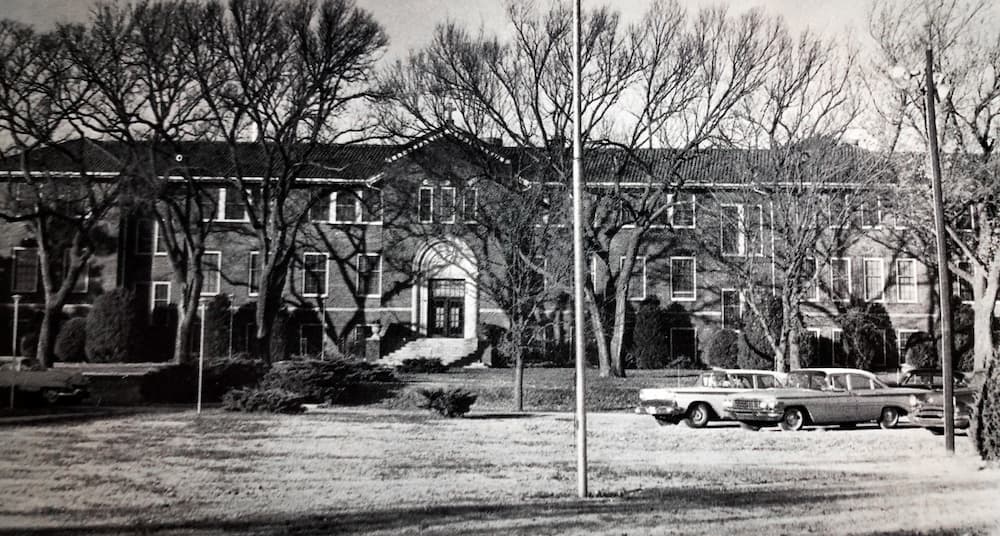
Resisting throwaway culture
In a world where it’s common to view all things as disposable, Jagger said she is glad to see that the Newman community didn’t adopt the same concept in regards to the 100-year-old Sacred Heart Hall.
“I have a certain reverence for history,” Jagger said. “Some things are meant to be preserved and I think this building is one of them.”
Wetta emphasized the importance of preserving buildings and landmark items for institutional history. The number of St. John Henry Newman items in the building, the photographs of past presidents, the Board of Trustees members and the ASC sisters all help community members understand the contributions others have made in the university’s history over time.
Just like the building itself, the statue of the Sacred Heart of Jesus within the entryway of Sacred Heart Hall also has historical significance. It was installed to recognize the importance of the prior names of the school — Sacred Heart Academy and Sacred Heart Junior College.
“The fact that all these items are located in this building is a testimony to its significance,” Wetta said. “In preserving the building, we’re preserving history and memories.”

In the upcoming Sacred Heart Hall renovation, St. John’s Chapel will remain untouched.
“We’re preserving a sacred space that has been sacred space since the building was built, and that’s really significant,” Wetta said.
All alumni are invited to take part in a community-wide gathering the weekend of June 23-25, 2023, which will feature an archival exhibit in Sacred Heart Hall and books of stories shared by alumni throughout this year. The university has plans to bury a new time capsule as part of the celebration.
“We hope all alumni will join us in giving thanks for God’s blessings that the university continues to receive to this day; giving thanks for all of the people — lay and sisters — who have taught and studied here and for the blessings of all the alumni who have influenced the common good for Newman over the years and continue to do so,” Wetta said.
Jagger encourages any member of the Newman community to contribute and share their own memories, stories and images of Sacred Heart Hall, as well as “anything else people have in their minds and hearts.”
Jagger concluded, “I’m excited to try to ensure Sacred Heart Hall’s longevity for another
100 years.”


